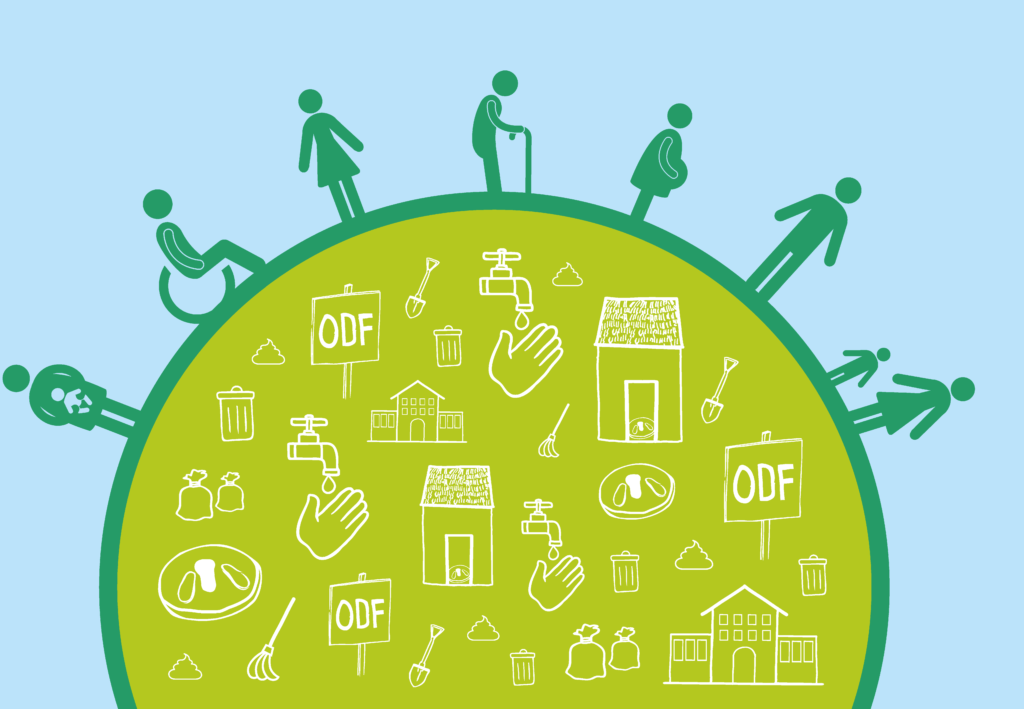In 2016, I wrote about the key role of Community Health Volunteers (CHVs) in post-Open Defecation Free (ODF) follow-up to sustain ODF status, looking at the financing and implementation of activities from the onset of Community-Led Total Sanitation (CLTS) programs. Key to these activities was identifying existing administrative and social structures that could be utilized in the Kenyan Community Health Strategy Approach (CHSA) prior to implementation. I also highlighted challenges around incentives to motivate CHVs and the risk of devolved government structures in relation to inequity among districts.
This blog looks at the progress made in Meru and Kitui counties in strengthening the critical role of CHVs by addressing some of the challenges identified in 2016.
CHVs as a key to improving healthcare for all Kenyans
Kenya’s Vision 2030 identifies the use of CHVs as key to improving healthcare for all Kenyans and as a proactive approach to health promotion that progressively shift the focus from curative to preventative. They are a vital component of Universal Health Coverage (UHC).
The Kenya Community Health Strategy 2020 – 2025 was developed after a situation analysis noted that several aspects of community health systems needed strengthening and scaling to unlock the potential of community health in Kenya. The Kenya Health Sector Strategic and Investment Plan July 2018–June 2023 and the Kenya Health Policy currently feature budget provisions for the community health strategy that previously was not covered by the Ministry of Health. This is a great national-level initiative; however, with health being a devolved function, there are no guarantees that national level plans translate into county level action.
Nevertheless, counties have made efforts to improve health services via community health and specifically CHV programs, recognizing them as the first level of care in the first schedule of the Kenya Health Act 2017. Specific functions of CHVs under the Act include:
- the promotion of healthy behavior among individuals and households;
- the provision of agreed-upon basic health services; and
- the facilitation of community diagnosis, management, and referral.
Individual counties have added specific activities for CHVs based on the programs they are implementing.
Who can become a CHV?
Originally, it was thought that CHVs would be mature women and men who lived in the communities for many years and had relevant skills for the various aspects of health promotion. However, a study in Meru County by IDinsight showed that the County’s Community Health Unit (CHU) was driven by a female, middle-aged workforce, most of whom had a primary school education and undertook farming as their main economic activity. The study also found that about half of the CHVs sampled were confident in their overall skills and knowledge to succeed in the role, but confidence levels varied across priority knowledge areas.
In Kitui County minimum requirements for the CHVs included secondary education, being over 30 years and a “permanent” member of the community. These are in consideration that CHVs are expected to facilitate various health-related activities ranging from WASH services promotion to postnatal care, TB, HIV and Malaria interventions, so basic education and relevant experience are a requirement.
What is the CHVs role?
A few years ago, CHVs were not recognized in any form by any of the authorities apart from tier 1 government workers who would engage them in an ad-hoc manner. This has changed. Kitui County has come up with a list of specific functions for CHVs that range from sensitizing communities for uptake of quality health services, mobilization of stakeholders, and coordinating community health activities including community dialogue, community action, and celebration days.
Meru County set out specific short-term projects that rely on a strong CHV program to achieve their goal of improving health services as part of its long-term development strategy. An example is the community door-to-door health campaign on hygiene, sanitation, and other preventative health strategies. The county believes that strong CHV programs lead to a citizenry that is more engaged in care decisions and reduces the financial burden on care within the health sector.
Opportunities and challenges
In Kitui county, a 5-year plan aims to train CHVs in groups of five, so that they operate together. They are supervised by village administrators, and receive technical support from Public/Assistant health officers. There is a clear plan on how many households each CHV would be allocated and what their specific roles would entail after the trainings. Meru county has gone further by considering accreditation and certification within their county for CHVs.
The IDinsight study highlighted that less than 50% of CHVs had access to smartphones, despite over 90% preferring digital reporting to current paper forms. The study further indicated that there were gaps in the utilization of the tools (e.g., manuals and guidelines) that CHVs received and the extent to which they responded to conditions within the community.
There is also a problem with government-issued toolkits not being regularly restocked despite many of the 22 items in the kits being perishables and consumables. CLTS triggering requires CHVs to have either soap or ash, but with the onset of the Covid-19 pandemic, the CHVs had to be part of the distribution network of triggering for hand sanitizers and soap, this expanded the role of the CHVs that they are known for.
The majority of CHVs in Meru cited lack of remuneration as a hindrance to their role. There is currently no documented evidence of how much is given to the CHVs.
Kitui county has an elaborate plan based on their “Pamoja Tujikinge Magonjwa Integrated Programme” (PATUMAP), for some remuneration. The CHVs are to be paid a monthly stipend of Kes.2000 (the equivalent of USD16.50) using a result-based reward model. There are plans to support CHVs to register for national health insurance for their families through county government support and for initiating income-generating activities that would provide CHVs with some form of income by year 3. This great initiative needs support from the County governments to guarantee returns on the businesses.
Whilst the supervisory and technical support for CHVs is commendable, the CHVs are expected to work as volunteers whereas the supervising and supporting individuals are remunerated for their work. So far, none of the counties have county health services bills for the remuneration of CHVs in place. A fair and systematic approach to remuneration is needed.
What has been put in place to support the CHVs work so far?
County governments have clearly invested in community health volunteers. Some of the emerging best practices include:
- Balancing age groups within the CHV cadre by recruiting youth and mitigating challenges to their retention. (Meru)
- Dropping secondary education as a requirement, recognizing that individuals can make a valuable contribution without it. (Meru)
- Supervision of CHVs by Community Health Extension Workers (CHEWs) and working within Community Health Units encompassing about 5,000 Kenyan citizens.
- Strengthening the Community Health Network through capacity building of CHEWs to adequately support and train the CHVs in their work. The relationships built during the capacity-building processes then ensures efficiency in referrals and data management
- Consideration of a revolving fund for restocking and purchasing toolkit items. However, this initiative is yet to be financed. (Meru)
- Allocation of Kes. 1000 (the equivalent of USD8.20) to CHVs as a start-up fund for income-generating activities for the CHV groups. These savings will be managed by the county government on the CHVs’ behalf. (Kitui)
Conclusion
Kenya’s community health program has led to improvements in key health indicators. The role of the CHV has expanded to include other health issues such as Covid-19. As of the end of 2019, Kenya had set up approximately 6,000 community health units that are supported by 86,000 CHVs. CHVs are supported by 1,569 Community Health Extension Workers (CHEWs).
There is much more that can be done to maximize the potential of the CHVs. The Covid 19 pandemic revealed both the need to enhance the robustness of the CHV program as well as exposing the risks of not doing so.
A more systematic policy and implementation plan including strategies for recruitment, utilization and retention of the CHVs is needed. Systems thinking in investing in CHVs would be a starting point for the various sub-national governments to attain universal health access for their citizenry.








